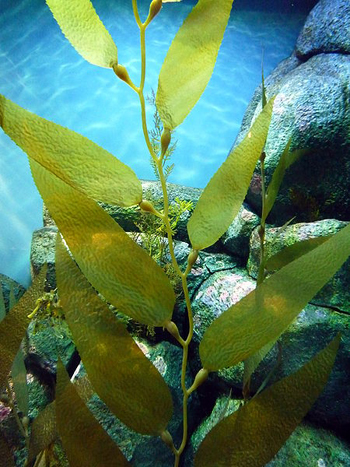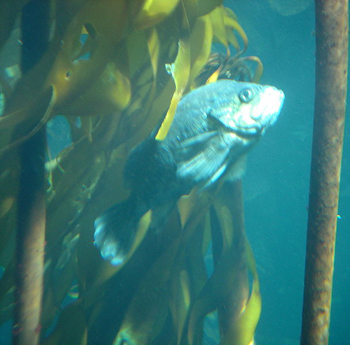Contents:
Common Names | Parts Usually Used | Plant(s) & Culture | Where Found | Medicinal Properties | Biochemical Information
Legends, Myths and Stories | Uses | Formulas or Dosages | Nutrient Content | How Sold | Warning | Resource Links | Bibliography
Scientific Names

- Fucus versiculosis L.
- Laminariaceae
- Algae family
Common Names
- Black tany
- Bladderwrack
- Bladder fucus
- Cutweed
- Hai-ts’ao (Chinese name)
- Kelpware
- Seaweed
- Sea oak
- Seawrack
Parts Usually Used
Whole plant
Back to Top
Description of Plant(s) and Culture
Seaweed: many species are used: Kombu
Back to Top
Where Found
Thrives in the salty waters of the Atlantic Ocean along the rocky shores.
Back to Top
Medicinal Properties
Expectorant, demulcent, emollient, alterative, diuretic, nutritive, thyroid tonic, antirheumatic, anti-inflammatory, metabolic stimulant
Back to Top
Biochemical Information
Mucilage, volatile oil, iodine, biotin, bromine, choline, copper, inositol, PABA, selenium, sodium, calcium, iron, alginic acid, mannitol, carotene, protein, riboflavin,
Back to Top
Legends, Myths and Stories

Several varieties of the seaweed have been therapeutically used. In the 18th century, iodine was isolated by distilling the long ribbons, or thalli, and kelp was the main source of iodine for more than
In China, Shen-ung wrote in
Harvesting marine crops in Japan is a thriving industry today; a practice since the ancient empire of Japan. The Japanese people refer to seaweed as “Heaven Grass,” highly regarded for its nutritional and medicinal value. Diving girls (ama) of coastal villages in Japan probe marine gardens of offshore lagoons in harvesting seaweed. These young women are graceful, hardy divers with superb figures and have become a proud tradition in Japan.
As far as known, kelp has no long range accumulative disadvantages; the body takes what it needs and discharges the rest. Minerals are not stored in the body. None of kelp’s natural store of elements are removed or lost from the time it is harvested to the time it is compressed into a tablet. Kelp tablets are worthy of a trial.
The Dutch use kelp for covering or packing lobsters and crabs, that are to be conveyed to a considerable distance; because it keeps them alive much longer than any other species of this plant; nor does it easily ferment, or become putrid.
Kelp is excellent fertilizer; it is asserted, that the land will continue unexhausted for
In the Hebrides islands, kelp serves as a winter food for cattle, which regularly frequent the shores for it, after the tide has ebbed. The inhabitants of these isles dry their cheese without using any salt, by covering it with the ashes of this plant.
Much of seawrack’s saline taste may be minimized by taking the powdered botanical in capsule or tablet form and following with a little red wine or flavorsome herb tea such as made with lemon grass, lemon verbena or sassafras.
Back to Top
Uses
Soothes irritated throat and mucous membranes, soothes cough, dissolves firm masses such as tumors, treats enlarged thyroid, scrofula, lymph node enlargements, normalizes a weak or enlarged prostate gland, swollen and painful testes, and reduces edema. Reported to be very beneficial to the sensory nerves, membranes surrounding the brain, spinal cord, and brain tissue. Use for hair loss, goiter, ulcers, and obesity. Good for arteries, rheumatism, and nails. Protects from effects of radiation, and softens stools.
Good for those with mineral deficiency.
Obesity (overweight) is seldom seen among the Polynesians and other races who use seaweeds as a regular part of their daily diet.
Back to Top
Formulas or Dosages
Infusion: steep 1 heaping tsp. in
Back to Top
Nutrient Content
Iodine, calcium, iron, sodium, potassium, phosphorus, magnesium, protein, carotene, riboflavin,
Back to Top
How Sold
Tablets
Back to Top
Warning
Generally contraindicated for patients with weak or deficient spleen or stomach.
Like many sea creatures, kelp is at risk from heavy metal pollution. Do not collect kelp where levels of cadmium and/or mercury are known to be high.
Chemical solutions of iodine or iodide enter the circulation almost instantaneously and larger amounts may cause allergic reactions unless used under close medical supervision. Plant iodine is absorbed slowly with other elements and rarely (if at all) causes sensitizing reactions when taken in reasonable amounts.
Back to Top
Resource Links
LiveStrong: What Are the Benefits of Kelp Tablets?
LiveStrong.com: What Are the Benefits of Taking Kelp?
LiveStrong.com: Bladderwrack for Children
LiveStrong.com: What Are the Benefits of Kelp Alfalfa?
U.S. National Library of Medicine: Kelp
Memorial Sloan-Kettering Cancer Center: Bladder Wrack
Internet Health Library: Hypothyroidism Research
Complementary Prescriptions: Kelp Supplements May Contain Arsenic
Ray Sahelian, M.D.: Kelp Supplement Benefit and Side Effects
Bibliography
![]() The Herb Book
The Herb Book, by John Lust, Bantam Books, 666 Fifth Avenue, New York, NY. copyright 1974.
![]() Back to Eden
Back to Eden, by Jethro Kloss; Back to Eden Publishing Co., Loma Linda, CA 92354, Original copyright 1939, revised edition 1994
![]() The Herbalist Almanac
The Herbalist Almanac, by Clarence Meyer, Meyerbooks, publisher, PO Box 427, Glenwood, Illinois 60425, copyright 1988, fifth printing, 1994
![]() The Nature Doctor: A Manual of Traditional and Complementary Medicine
The Nature Doctor: A Manual of Traditional and Complementary Medicine, by Dr. H.C.A. Vogel; Keats Publishing, Inc., 27 Pine Street (Box 876) New Canaan, CT. 06840-0876. Copyright Verlag A. Vogel, Teufen (AR) Switzerland 1952, 1991
![]() Planetary Herbology
Planetary Herbology, by Michael Tierra, C.A., N.D., O.M.D., Lotus Press, PO Box 325, Twin Lakes. WI 53181., Copyright 1988, published 1992
![]() American Folk Medicine
American Folk Medicine, by Clarence Meyer, Meyerbooks, publisher, PO Box 427, Glenwood, Illinois 60425, 1973
![]() Prescription for Nutritional Healing, Fifth Edition: A Practical A-to-Z Reference to Drug-Free Remedies Using Vitamins, Minerals, Herbs & Food Supplements
Prescription for Nutritional Healing, Fifth Edition: A Practical A-to-Z Reference to Drug-Free Remedies Using Vitamins, Minerals, Herbs & Food Supplements, by James F. Balch, M.D. and Phyllis A. Balch, C.N.C., Avery Publishing Group, Inc., Garden City Park, NY
 Secrets of the Chinese Herbalists
Secrets of the Chinese Herbalists, by Richard Lucas, Parker Publishing Company, Inc., West Nyack, NY, 1987.
![]() Webster’s New World Dictionary
Webster’s New World Dictionary, Third College Edition, Victoria Neufeldt, Editor in Chief, New World Dictionaries: A Division of Simon & Schuster, Inc., 15 Columbus Circle, New York, NY 10023
 Old Ways Rediscovered
Old Ways Rediscovered, by Clarence Meyer, Meyerbooks, publisher, PO Box 427, Glenwood, Illinois 60425, published from 1954, print 1988
![]() The Complete Medicinal Herbal
The Complete Medicinal Herbal, by Penelope Ody, Dorling Kindersley, Inc, 232 Madison Avenue, New York, NY 10016, First American Edition, copyright 1993
![]() The Yoga of Herbs: An Ayurvedic Guide to Herbal Medicine
The Yoga of Herbs: An Ayurvedic Guide to Herbal Medicine, by Dr. David Frawley & Dr. Vasant Lad, Lotus Press, Twin Lakes, Wisconsin, Second edition, 1988.
 The Magic of Herbs in Daily Living
The Magic of Herbs in Daily Living, by Richard Lucas, Parker Publishing Co. (1988).
